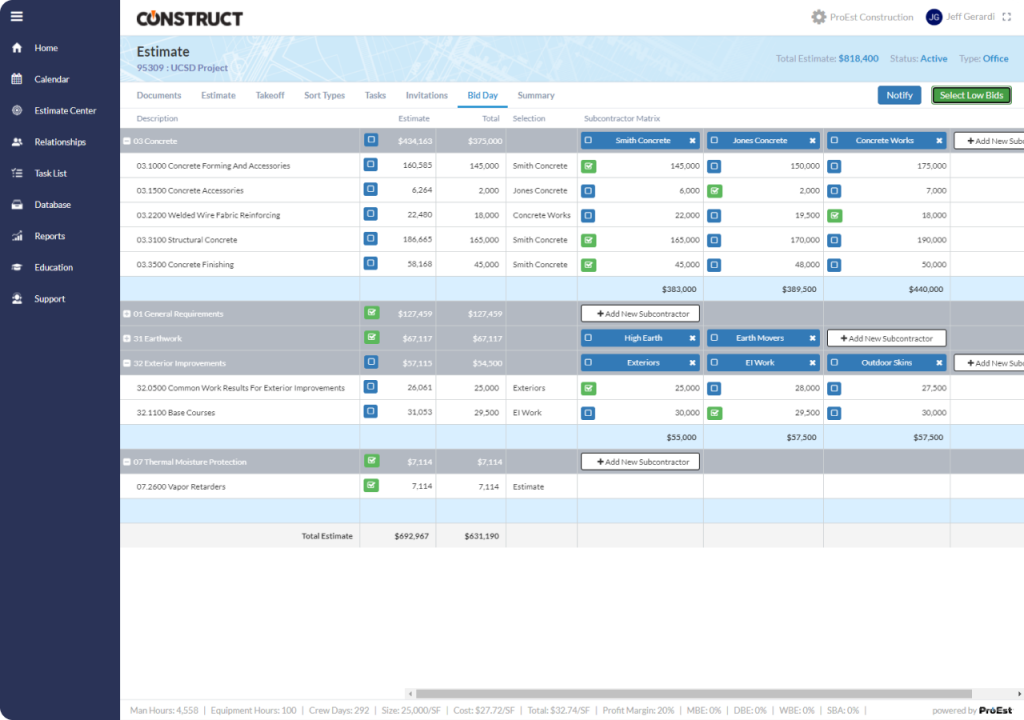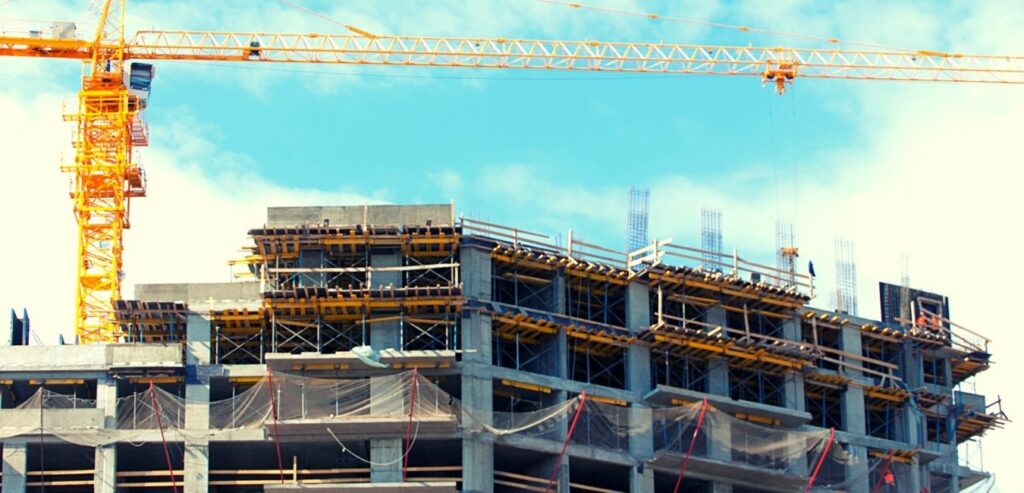In the construction bidding process, clients have to make several interdependent decisions based on the limited information on a contractor. There are different bidding strategies in construction projects, and the client needs to know how to analyze the bids appropriately and choose the best-qualified contractor.
Refining the bid analysis process helps clients find the best productive contractor to help them complete projects successfully.

Table of Contents
What is bid analysis?
Bid analysis involves examining bids after the tender submission deadline. It helps identify the most suitable offer that meets the client's needs.
When conducting bid analysis, the client should consider their objectives and project-specific criteria such as safety, security, maintenance, and durability. The bidding parties should present clear and organized bids to make sure their proposals are comprehensible and improve their chances of success. The evaluation process has many components, and the client needs to combine various standards into one evaluation scale.
Why is bid analysis important?
- To get a responsive bid: The main purpose of bid analysis is to ensure you get the best responsive bid concerning the specified job requirements.
- Solution-oriented: Bid analysis helps clients find the right bid for their particular project. Construction bidding is not a "one-size-fits-all" process, as each project is unique. Evaluating bids helps clients identify the bidder that can best address their project's specific needs.
Projects aim to add value. Bid analysis can help you identify a company's contribution to a project. Evaluating a bid involves considering metrics such as expected project quality and projected cost.
The lowest bid isn't always the best option. It's wise to go through the bid evaluation process to get the most value from a bid.
How are bids evaluated?
The bid analysis process takes place in four stages. These are:
- Preliminary evaluations
- Compliance with technical requirements
- Price evaluation
- Due diligence
#1 Preliminary evaluations
The client's team will evaluate each bid during the preliminary stage. They will check if the bid is signed, has the necessary security, and contains no omissions or errors. Additionally, they will assess if the documents meet all legal and tax requirements. Bids that do not meet these conditions will not advance to the next step.

#2 Compliance with technical requirements
The second stage is to assess if the bid meets the technical requirements for the project. These include the material quality, delivery timeline, scope of works, warranties, and the bidder's experience. The technical specifications vary depending on the project.
#3 Price evaluation
The next step is price evaluation. Here the main evaluation point considered are costs and their influencing factors, such as unit pricing, labor rates, labor hours, overheads and profits, price lock (the duration price is guaranteed), material costs, quantities, and quality.
The panel takes provisional sums and discounts into consideration. If the bids are in multiple currencies, they are converted to a single currency based on exchange rates from one source.
The evaluation team arranges the bids from highest to lowest price. They also create a price analysis to determine if the bid prices are reasonable in relation to the current market.
#4 Post-qualification
The last step is post-qualification. It only applies to the winning bid. The evaluation team must do their due diligence to ensure the bidder provided accurate information and met all prequalification requirements.
Breakdown of a bid analysis
After receiving the solicited bids, you can start the bid analysis process. The bid analysis process has various evaluation criteria depending on the type of bid. Below is a breakdown of the bid analysis process:
- Preliminary analysis: The first step is a preliminary analysis to ascertain whether a bid is responsive to the tabulated requirements. Some requirements assessed are whether the bid is from eligible companies and whether these companies meet their legal and commercial requirements. Bids considered non-responsive during the preliminary stage do not proceed to the next evaluation stage.
- Technical evaluation: The second part of a bid analysis is a technical evaluation, whereby the panel evaluates a bidder’s experience, schedule of works, warranties, defects liability period, and compliance with specified quantities. The technical requirements are not fixed and vary from project to project. Unsuccessful bids do not continue to the next stage.
- Financial evaluation: Here, the evaluation team checks the offered price, whether it has computational errors, and considers provisional sums and discounts. The corrected bids are then ranked from the lowest to the highest responsive bid. After the financial evaluation, the clear winner is then awarded the bid.
Technical bid analysis
Project owners break down their projects into packages and then advertise for bids. They usually require bidders to submit proposals in two parts - a technical and commercial bid.
The technical bid analysis evaluates the bidder's documents to see if they meet the client's technical requirements. These include quality, experience, operating costs, specifications, execution capabilities, performance penalties, and other requirements such as compliance checks, licenses, and workforce sources.
The engineering team and the consulting engineer assess the technical bids and decide whether to approve or reject them. They list the specification requirements and attach the bids' technical queries, deviations, and justification lists. The client's team evaluates the deviations and issues the technical bid analysis for final approval.
Once the engineering team determines the acceptability of the technical aspect of the bid, they move on to open the commercial part of the bids of the technically qualified bidders. This process of exchanging information between owners, engineers, and vendors is called technical evaluation or technical bid analysis.
After approvals, the qualified bidder is issued with the finalized contract specifications.

Commercial bid analysis
Commercial bid analysis helps you get the best cost-effective deal for your project. The assessment is based on several criteria, such as price analysis, delivery schedule, and proposed contractual terms and conditions.
The client's cost consultant, quantity surveyor, or architect is responsible for checking if the bidders meet all the evaluation categories. This assessment ensures that all costs are adequately covered according to the bid documents. It also verifies that the bids are comparable and currency conversions are accurate at the bid time. Any price escalations or alternative methods for meeting specifications are identified and logged separately.
The evaluation team also logs extra costs such as insurance, customs, delivery fees, testing, and inspection charges. They further evaluate retentions and terms of payment.
The assessment criteria above provide an overview of the cost components to consider. If the size or quality of the project changes, bidders may need to submit a new bid.
In addition to quality and cost, the commercial evaluation of a project also considers its social value. This term refers to the additional benefits a project brings to a community. In the past, only quality and cost were taken into account, but the social value has become an integral part of a successful bid.
Economic assessments of social value may include job growth in the local area, voluntary work, and training opportunities.
Once the tendering process is complete, the winning bid is awarded the contract, and work can begin.
Top tips to win a bid
Below are the top basic tips for winning a bid.
- Bid selectively: Construction bidding takes time, so it's wise to focus on tenders you're likely to win, rather than contracts with a low success rate.
- Be prepared: Make sure your company meets the minimum requirements. Standardize your policies, financial reports, and insurance and make them available electronically.
- Answer all questions fully: Don't assume the reader knows much about your company. Inadequate answers can cause your bid to fail.
- Follow the submission requirements: Check the required format and stick to it. Don't rush and miss any requirements.
- Use appropriate tender documents: Ensure your documents comply with the bid requirements and answer the questions. Proper documents ensure you put the right information in the right place.
- Form professional networks and relationships: Having a relationship with a client's organization can increase your chances of success. However, this doesn't apply to public sector contracts.
- Give the right references: When offering references, make sure they are relevant and similar to the project you're bidding for. Clients usually look for companies with experience in the job they offer.
- Give an accurate quotation: Ensure your pricing is as accurate as possible. Consider using cost estimation software for the best results.
- A unique selling point: Most bidders add a lot of fluff to their bids, but clients can see through this. Think about what your business offers that's different and show how it will benefit the buyer.
Summary
Construction bidding can feel like a gamble, but you can use data to make smart decisions. Knowing the bid analysis process helps you follow the rules and increase your chances of winning the best projects.


